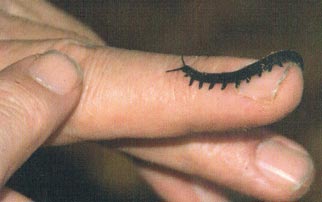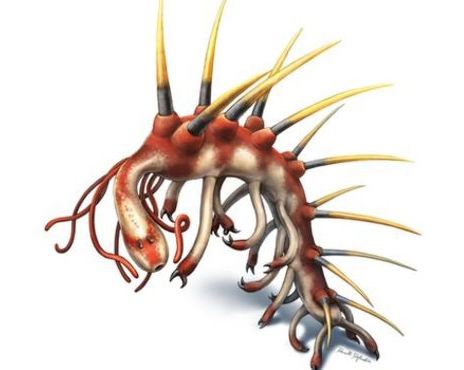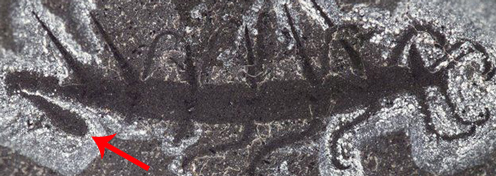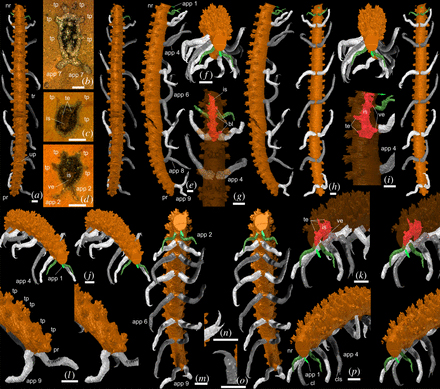Rare Silurian Fossil “Worm” from a Herefordshire Hotspot
A New Species of Lobopodian from Herefordshire
Fossil worm excites palaeontologists. Three-dimensionally preserved lobopodian from Herefordshire.
A team of international researchers including scientists from the Oxford University Natural History Museum, Imperial College London, Manchester and Leicester Universities and the Yale Peabody Museum of Natural History, have identified a new species of lobopodian, a bizarre segmented worm-like creature, in 430 million-year-old rocks in Herefordshire (England). Digital technology has been utilised to reconstruct a three-dimensional model of this exceptional fossil, an ancient ancestor of the modern, enigmatic Velvet worm.
The Research Team Produced Three-dimensional Images of the Fossil Lobopodian
Picture credit: University of Leicester
Soft-bodied, Worm-like Creatures with Legs
Lead author of the study, Derek Siveter, (Professor Emeritus of Earth Sciences at Oxford University and Honorary Research Associate at Oxford University Museum of Natural History), commented:
“Lobopodians are extremely rare in the fossil record, except in the Cambrian Period. Worm-like creatures with legs, they are an ancestral marine relative of modern-day velvet worms, or onychophorans – predators that live in vegetation, mainly in southern latitudes.”
The Velvet Worm (Peripatus Genus)

Picture credit: BBC
The Evolution of the Arthropods
Palaeontologists have puzzled for decades over the evolution of groups of modern animals such as the Arthropoda, the largest phylum of animals which includes the trilobites, insects, crustaceans, spiders, scorpions, mites and so forth. Studies of the exotic Ediacaran and Cambrian biota has helped scientists to better understand the evolutionary relationships between living groups of animals today and their ancient invertebrate ancestors, but many soft-bodied groups are severely underrepresented in the fossil record.
Thanahita distos
It is still extremely difficult to pin down which type of organism preserved within the remarkable Cambrian-aged Burgess Shale deposits for example, is an ancestor of modern groups of animals alive today. This newly described fossil specimen, named Thanahita distos represents an example of a member of the Lobopodia, an extremely ancient group of invertebrates that might be a basal member of the panarthropods – a clade that includes today’s arthropods, as well as Velvet Worms (Onychophora) and the Water Bears (tardigrades).
The Silurian-aged deposits in Herefordshire, consist of finely grained volcanic ash layers that settled on a seabed some 430 to 425 million years ago. These sediments have preserved in exquisite detail many of the marine organisms that roamed across the sea floor. Writing in the Royal Society Open Science journal, the researchers describe T. distos and note that it is the first lobopodian to be formally described from rocks from the Silurian and it is one of only eight known three-dimensionally preserved lobopodian or onychophoran fossil specimens known to science.
Professor Siveter explained how the team were able to build up a picture of the ancient sea creature:
“We have been able to digitally reconstruct the creature using a technique called physical-optical tomography. This involves taking images of the fossil at a fraction of a millimetre apart, then “stitching” together the images to form a “virtual fossil” that can be investigated on screen.”
Herefordshire Lagerstätte
The Herefordshire Lagerstätte has provided scientists with numerous exceptionally preserved invertebrate fossils. Everything Dinosaur has reported on several of these, very significant fossil discoveries on this blog, including one Herefordshire fossil which was named in honour of Sir David Attenborough:
Silurian Fossil Discovery Honours Sir David Attenborough.
Professor Siveter outlined how delicate creatures like Thanahita distos became preserved, he stated:
“Thanahita distos and the other animals that became fossilised here likely lived 100 to 200 metres down, possibly below the depth to which much light penetrates. We deduce this because we found no vestiges of photosynthetic algae, which are common in contemporaneous rocks laid down at shallower points on the seafloor to the east.“
Professor Siveter added:
“Some special circumstances allowed for their remarkable preservation. The first was the immediate precipitation of clay minerals around the dead organisms, which decayed over time, leaving empty spaces behind. The mineral calcite – a form of calcium carbonate – then filled these natural moulds, replicating the shape of the animals. Almost at the same time, hard concretions began to form, being cemented by calcite. Thanks to the early hardening of these Silurian time capsules in this way, the fossils were not squashed as the ash layer slowly compacted.”
Fossil Worm Related to the Enigmatic Hallucigenia
A phylogenetic analysis undertaken by the researchers placed T. distos, together with all the described Hallucigenia species, in a sister-clade to crown-group the panarthropods. Its placement in a redefined Hallucigeniidae, an iconic Cambrian clade, indicates the survival of these types of creatures into Silurian times.
The Newly Described Thanahita distos is Placed Within the Enigmatic Hallucigeniidae

Picture credit: Danielle Dufault
The professor stated:
“Some lobopodians lie in a position on the tree of life which foreshadows that of the terrestrial velvet worms, while others are precursors of the arthropods: the “king crabs”, spiders, crustaceans and related forms. Since its discovery, the Herefordshire Lagerstätte has yielded a diversity of arthropods that have contributed much to our understanding of the palaeobiology and early history of this very important invertebrate group. The lobopodian Thanahita distos belongs to an extended, panarthropod grouping.”
A Spectacular Herefordshire Specimen (Fossil Worm)
The discovery of the Herefordshire specimen and its subsequent phylogenetic analysis indicates that the lobopodian group, which is associated with Late Cambrian strata, persisted into the Silurian, thus demonstrating that these creatures survived for at least 100 million years.
A Fossil of Hallucigenia Specimen from the Late Cambrian Rocks of British Columbia

Picture credit: Royal Ontario Museum/Dr Jean Bernard Caron
The scientific paper: “A Three-dimensionally Preserved Lobopodian from the Herefordshire (Silurian) Lagerstätte, UK” by Derek J. Siveter, Derek E. G. Briggs, David J. Siveter, Mark D. Sutton and David Legg published by the Royal Society Open Science
Visit the award-winning Everything Dinosaur website: Everything Dinosaur.


